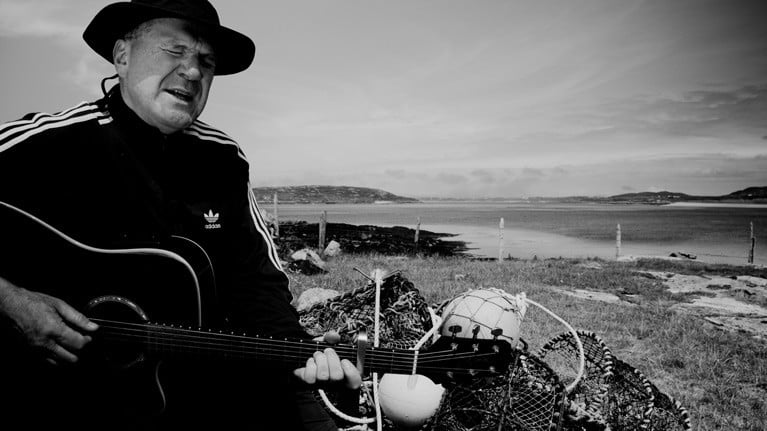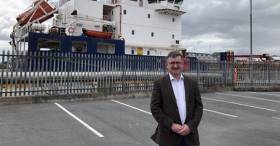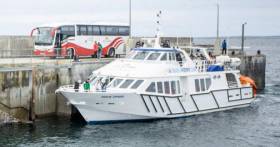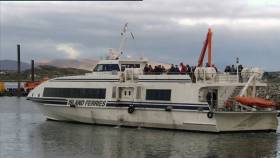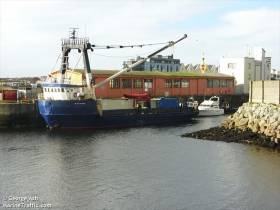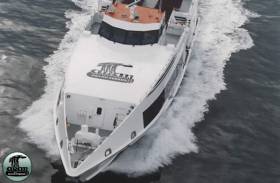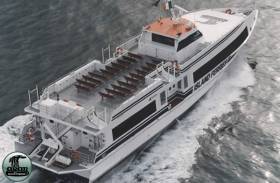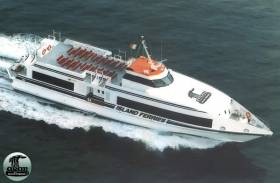Displaying items by tag: Island News
Valentia Island Ferry Returns With Seasonal Service Today
In scenic west Co. Kerry the Valentia Island car-ferry started today with the resumption of the seasonal service which runs from April to October, writes Jehan Ashmore.
The ferry service which is near Cahirciveen on the Iveragh Peninsula, connects Renard on the mainland to Knightstown on the east of Valentia Island, part of the Wild Atlantic Way.
Operating the route is Valentia Island Ferries with their God Mets On III that plies on the five-minute route which is based on a continuous shuttle service throughout the day.
Domestic and tourist vehicles using the 43m double-ended ferry include cars, MPV's, motorhomes, campers, mini-buses, cars with caravans and trailers, commercial vans, motorbikes. In addition to conveying bicyles and foot passengers.
The veteran vessel built in 1963 had originally served in The Netherlands across the River Maas until replaced by a bridge. Since 1996 the ferry has operated to Valentia which is approximately 11kms in length and 3 kms wide.
The 95 gross tonnage ferry runs the first and final crossings each day from Knightstown.
It was here in 1858 when HMS Agamemnon landed the first transatlantic telegraph cable, linking Knightstown to Hearts Content Newfoundland, Canada.
To the west of Knightstown at Cromwell Point is Valentia Island Lighthouse, the most westerly harbour light on the island of Ireland. It is a tourist attraction and is open to bookings.
On the middle of the island is Geokaun Mountain and cliffs, the highest point of the Island with stunning panoramic views of Kerry which have been designated as a Discovery Point on the Wild Atlantic Way.
A road runs along about two-thirds of the island from Knightstown to a bridge on the south of the island. The bridge which opened in 1970 connects to Portmagee on the mainland.
Prior to the completion of the bridge, a passenger/cargo ran between Reenard Point and Knightstown.
Funding for Offshore Island Road Repairs to be "Ring-Fenced"
Funding for roads on Ireland’s offshore islands is to be “ring-fenced” for the first time under a scheme announced by Minister for Rural and Community Development Heather Humphreys.
A sum of 0.5 million has been earmarked specifically for islands as part of a 12.5 million euro national scheme for repairs and improvements on rural roads and laneways.
This investment will benefit island communities in Galway, Cork, Donegal, Mayo and Sligo, her department says.
The funding, under the Local Improvement Scheme (LIS), will support the continued improvement of non-public roads and lanes that are not normally maintained by the local authorities, it says.
“The investment is key to supporting vital road infrastructure in rural communities, as well as providing access to homes, farms and outdoor amenities such as lakes, rivers and beaches,”it says.
A total of €112 million has now been allocated to local authorities under the Local Improvement Scheme since it was re-introduced in 2017, and over 3,700 roads have been funded for repairs.
“Having visited many of our offshore islands in recent months, I know that there are many road projects in need of investment,” Humphreys said, stating this demonstrated her commitment to island life.
2023 Local Improvement Scheme Ireland's Offshore Islands Allocations
 2023 Local Improvement Scheme Islands Allocations
2023 Local Improvement Scheme Islands Allocations
When three Connemara islanders drowned on their way home in a currach from watching the All-Ireland football final on television in Clifden in 1974, their loss had such a devastating impact that most of the residents of Turbot evacuated four years later.
A population of 191 people living on the island just west of Clifden in the 1860s had declined to around 65 by then and most of the islanders left in 1978, all together on the same day.
The final seven quit in 1981, leaving crockery in cupboards, ashes in fireplaces and pencils and copy books on desks in the primary school.
 Turbot Island off the coast of Connemara
Turbot Island off the coast of Connemara
Now some 46 years later, the short lives of the fishermen, Patrick O’Toole (58), Patrick Stuffle (48) and Michael Wallace (62), and the fate of their islands has been commemorated with a music and video project, initiated by “new islanders” who have holiday homes on Turbot.
Original and “new” Turbot residents marked the occasion at a launch of the project in Clifden’s Abbeyglen Castle Hotel yesterday.
 Peter Knox and Turbot islander John O'Toole
Peter Knox and Turbot islander John O'Toole
Turbot, which is south of Omey, had made history as the first land sighted by the first successful trans-Atlantic aviators John Alcock and Arthur Whitten Brown, who crash-landed in Derrygimlagh bog near Clifden on June 15th, 1919.
Years later, when Dutch advertising executive Stefan Frenkel and his wife Hanneke bought a house on Turbot, they heard how the mainstay of fishing, farming and growing vegetables had sustained it until the turf began to run out and emigration began to bleed the island dry.
The final straw was the loss of the three fishermen, who had left Eyrephort beach in bad weather for home after watching the match. It took three weeks to find their bodies.
“After the event, a Connemara resident Joseph O’Toole wrote a poem that describes all that had happened and the effect it had on the small island community,” Frenkel explains.
“His daughter Marie Joe Heanue said his father was a very good friend of the fishermen, and they often came for tea and stayed in their house when the weather was bad,” Frenkel recalls.
“ When their bodies were found, he was devastated. He wrote every evening for days, and Mary says they didn’t know what he was writing about,” Frenkel says.
Frenkel recalls that on his first visit to Turbot, islander John O’Toole “showed us the empty houses, beds.. the books and pencils still on the school desks...as if the pupils had just run out of the place yesterday”.
 Landing at Turbot Island
Landing at Turbot Island
The Dutch couple spent their first summer of many there in 1995, and said they were always made welcome by original Turbot residents, now resettled on the mainland, who said they “loved to see the houses occupied again”.
Turbot was connected to ESB mains in 2003, and over the past two decades, more houses have been sold, mostly to Irish owners, and the island has had its own wedding.
 The old schoolhouse on Turbot Island
The old schoolhouse on Turbot Island
At that wedding, John O’Toole recited the poem written by Joseph O’Toole, and another “new islander”, mathematician and musician Peter Knox from Dublin, asked for the text.
He matched the lyrics to music and it has now been recorded as a video by director Barry Ryan.
“My son Kasper recorded the music in his Electric Monkey Studio in Amsterdam, with Peter Knox, two musicians, Laurens Johansson and Ian de Jong and backing vocals from my granddaughter Leaf,” Frenkel, who financed the project, says.
“We hope Turbot Men, which will be free to view on YouTube, will become a new Irish ballad.”
Ferries from Galway City to the Aran Islands will after a lenghtly absence make their return to Galway Docks – with the announcement that Island Ferries will begin operating the service from next year.
According to the Connacht Tribune from May 2020, a vessel that is currently under construction in the Far East will become the largest domestic ferry on the Irish Coast and “will bring a new experience for passengers, never seen on Galway Bay before”.
That’s according to CEO of the Port of Galway, Conor O’Dowd, who said the new ferry was just one of a raft of exciting developments for the port – including the delivery of a new crane allowing for increased business and long-awaited progress on plans to extend the port.
For more on this ferry service development click here.
Afloat.ie adds that existing passenger services are operated west of Galway City from Rossaveal in Connemara in addition to those based out of Doolin in Co. Clare.
The last State run operated Galway-Aran ferry service ended in the summer of 1988 when Córas Iompair Éireann (CIÉ) used the custom Dublin-built Naomh Éanna completed at the Liffey Dockyard in 1958 to provide the joint passenger and freight service. As previously reported the veteran vessel is undergoing restoration to serve as a floating luxury hotel on the Liffey.
Another custom built ferry Oileáin Árann built in 1992 but privately operated by Doolin based O'Brien Shipping served the direct city-islands route. Notably, this was the final ship to provide this link until sold to Samskip an Icelandic based company.
A cargo-only service currently maintains sailings between Galway and all three Aran Islands. This is operated by Lasta Mara Teoranta's cargoship Bláth na Mara.
#ferries - A new service has been launched by Bus Éireann in partnership with Doolin Ferry Company for people to explore the Wild Atlantic Way, reports GalwayDaily.
The new Route 350 which operates from Galway offers a combined bus and ferry service exploring the sights of the Wild Atlantic Way with tour of the Cliffs of Moher or a day ticket out to Inis Oírr.
Customers can avail of two combined ticket options which each cost €38.50 for both the bus ticket and either a 1-hour ferry tour of the Cliffs or a trip out to Inis Oírr.
The bus route also offers a regular service from Galway, through Doolin and on to Ennis that runs up to six times daily.
Bus Éireann describe the new route as a “great value day trip option to visit Ireland’s most popular tours destinations along the very popular Wild Atlantic Way.”
To read more and where to buy tickets, click here.
Oireachtas Hearing Over Aran Ferry Service
#AranIslands - An Oireachtas committee on Arts, Heritage, Regional, Rural and Gaeltacht were addressed (yesterday) by a group of representatives from Inis Mór, the largest of the Aran Islands as a dispute over a ferry service to the island continues.
RTE News reports that Cathy Ní Ghoill, from the co-op on Inis Mór, said islanders have been battling for four years to keep basic services like air and ferry connections, and a change of policy is needed.
Local secondary school principal Micheál Ó Cualáin said a reliable air and ferry service was essential to bring teachers to and from the mainland.
For more on this ongoing story, click here.
Aran Islands Snapshot: Galway Port Based Freight Operator Serves Islanders Essential Daily Needs
#AranIslands – As talks today to resolve the ongoing Aran Islands ferries dispute over passenger levies with Galway County Council, Afloat.ie takes a snapshot of a separate but freight-only operator providing vital supplies to islanders, writes Jehan Ashmore.
The affected Island Ferries Teoranta passenger ferry service: Rossaveel-Kilronan on Inis Mór, the largest of the Oileán Árann / Aran Islands was due to end last week, however, as Afloat previously covered the service is still operating as “a gesture of goodwill to the Islanders”.The ferry service will remain in place until 17 January 2017 however this date remains under review subject to how the discussions progress on the council-imposed passenger levy for the non-PSO ferry route to Inis Mór. In recent years this route has been subject to a sharp rise in fares.
As for the freight-only operator, Lasta Mara Teoranta, the company since 2005 has the Government contract to carry cargo not just serving Inishmor but also Inis Meain and Inis Oirr. These services are an essential lifeline for islanders. Lasta Mara is the main cargo company serving the Aran Islands by operating from the mainland based in Galway Port using MV Bláth na Mara (1983/330grt).
All the daily needs of the islanders are carried in containers on board Bláth na Mara from food stuffs (chill and frozen), to household goods, furniture and fuel. As for larger items such as vehicles and old fashioned form of transport that includes horses (given the tourist jaunting carts) and other lifestock are also conveyed on the coastal freighter.
A ‘roll-on roll-off’ i.e. ro-ro service from Rossaveel, Connemara is also provided by Lasta Mara using the MV Chateau-Thierry (see report photo) a former US Army tank landing craft. As previously reported the vessel brought emergency electrical generators due to power-cuts earlier this year.
Otherwise Chateau-Thierry's routine heavy goods cargoes are in the form of trucks, diggers and heavy plant and machinery. Such construction related vehicles were transported by Chateau Thierry from the mainland to Kilronan Harbour during the building of the new harbour. These vehicles rolled off the bow loading ramp onto the sandy beach at Kilronan, the capital of the Aran Islands.
The costs to pay for Kilronan's new outer harbour (see engineering award) are derived through the passenger levies which are at centre stage of the ferry dispute.
As for the cargo service in order to maintain all perishable cargoes remain frozen before departing Galway Port, the outer pier is where a warehouse is equipped adjacent to where Bláth na Mara berths. The Galway-Aran Islands routes should also be noted as Ireland’s longest distance domestic (island serving) commercial cargo service.
It is on such trading routes that the old traditional joint passenger /cargo service had run up to 1988. This was carried out by the State owned Coras Iompair Eireann (CIE) group’s vessel Naomh Éanna.
The veteran vessel built by Dublin Liffey Drydock Company in 1958 ran on the route for four decades. Since the service closed Naomh Eanna has remained languishing in the capital’s Grand Canal Dock Basin. In recent years she was transferred to a disused graving dock having been saved from scrapping. Against this backdrop there have been plans to restore the historic Irish built ship.
Further Talks On Ferry Service to Inis Mór Aran Islands
#AranIslands - Talks are to resume on Friday writes Galway Independent in a bid to ensure the continuation of the ferry service to Inis Mór, Aran Islands.
The Island Ferries service ceased last Wednesday and was due to remain out of action until 17 March next year after the family-run company said it “had been left with no further option but to take such drastic action”.
The service however resumed on Friday evening, following talks between the company, Galway County Council and the Department of the Gaeltacht. The service will now remain in place until 4 January 2017, in “a gesture of goodwill to the Islanders”. This date will be kept under review as discussions continue.
Kevin Kelly, Acting Chief Executive of Galway County Council, said the talks, which centre on passenger levies, are complex but there is a “meaningful engagement process in place”.
“We are working as good as we can to conclude this within the timeframe. It is important that there is progress being made and that all parties feel that the overall approach has the possibility of reaching a successful conclusion.”
Ferry Service to Inis Mór Aran Islands to Resume This Evening While Talks Continue
#AranIslands - Ferry services to Inis Mór, the largest of the Aran Islands will resume this evening, while talks continue to find a long term solution with regard to a year-round service.
The Connacht Tribune writes that Island Ferries, Gaeltacht Minister Sean Kyne and County CEO Kevin Kelly met for talks this morning as Inis Mór residents faced into a second day without a ferry service.
The Island Ferries service ceased on Wednesday, and was due to remain out of action until March.
Last evening, County Councillors gave CEO Kevin Kelly a mandate to meet with Island Ferries on their behalf.
Today’s meeting was also attended by Gaeltacht Minister Sean Kyne and as Afloat previously covered he had called for the Naval Service to provide a short-term service to residents.
In a statement to NewsBreak, Galway County Council has confirmed that Island Ferries, as a gesture of goodwill, will resume its service to Inis Mor from 5 this evening until January 4th.
In the interim, talks will continue in a bid to ensure a year-round service for islanders and visitors.
Naval Service Examined As Possible Short Term Solution of Ferry Crisis to Largest of Aran Islands
#AranIslands - The use of the Irish Naval Service to provide a short-term service to residents on Inis Mór (largest of the Oileán Árann /Aran Islands) is being explored by Gaeltacht Minister Sean Kyne.
As Galway Bay FM reports the proposal follows the planned withdrawal of the winter service to the largest Aran Island until March 2017, with the last ferry set to depart at 6pm this evening (yesterday, 30th November).
Operator Island Ferries Teoranta has reaffirmed it’s intention to suspend the service – citing the ‘negative fiscal conditions’ created by the local authority with the introduction of passenger levies.
For more on the developing story, click here.
Afloat.ie adds that vital sea transportation links to Inis Mór are still been maintained albeit by a cargo-only operator, Lasta Mara Teoranta. This company serves the three islands from the mainland not just out of Rossaveel in Connemara but also Galway Port.
As of this morning Afloat.ie monitored their coastal freighter MV Bláth na Mara that departed Inis Oirr bound for Galway Port's outer pier. This is the final leg of a round trip that previously included calls firstly to Inis Mór followed by Inis Meáin.
Another crises that faced islanders was in August when Lasta Mara's other freight ro-ro vessel MV Chateau-Thierry came to the aid of two of three islands with generators that were used to restore electricity. This followed power-cuts caused by a damaged subsea cable connecting the mainland.



























